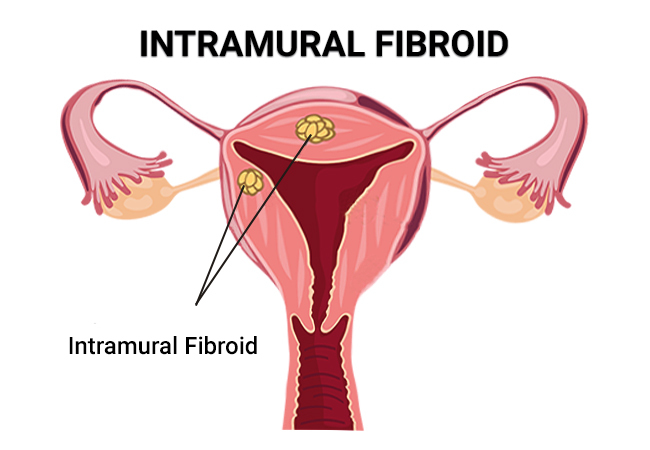Intramural fibroids are one of the most common types of uterine fibroid, a noncancerous growth that develops within the muscular wall of the uterus. While these fibroids may not always cause noticeable symptoms, they can lead to discomfort, pain, and other complications in some cases. In this article, we will explore the symptoms, causes, diagnosis, and treatment options for intramural fibroids, with a focus on surgical interventions when necessary.
Types of Intramural Fibroids
Intramural fibroids are non-cancerous growths that develop within the muscular wall of the uterus. They can vary based on their location within the uterus, which can influence the symptoms a woman experiences. Below are the different types of intramural fibroids based on their specific location:
- Anterior Intramural Fibroids
- These fibroids grow on the front wall of the uterus. Due to their position, anterior intramural fibroids can press against the bladder, potentially causing urinary symptoms such as frequent urination or difficulty fully emptying the bladder. Women with anterior fibroids may also experience discomfort in the lower abdomen.
- Posterior Intramural Fibroids
- Posterior intramural fibroids form on the back wall of the uterus. When these fibroids grow large, they can put pressure on the rectum, leading to symptoms like constipation or lower back pain. The pressure from posterior fibroids may also cause discomfort during bowel movements.
- Fundal Intramural Fibroids
- Fundal intramural fibroids are located at the top part of the uterus, known as the uterine fundus. These fibroids may not cause as much pressure on nearby organs as anterior or posterior fibroids, but they can still lead to symptoms like heavy menstrual bleeding, prolonged periods, or difficulties with fertility depending on their size.
Symptoms of Intramural Fibroids
Intramural fibroids can manifest with various symptoms, and the severity can vary from person to person. Some common symptoms of these uterine fibroids include:
- Menstrual Changes: Women with intramural fibroids may experience heavier or prolonged menstrual bleeding.
- Pelvic Pain: Fibroids can cause pelvic pain or pressure, leading to discomfort and a feeling of fullness in the lower abdomen.
- Backache or Leg Pains: Large intramural fibroids can exert pressure on surrounding nerves, resulting in backache or leg pains.
- Frequent Urination: Fibroids can press against the bladder, causing a frequent urge to urinate and UTI.
Difficulty Emptying the Bladder: In some cases, fibroids may obstruct the bladder, making it challenging to empty.
Causes of Intramural Fibroids
- The exact cause of these fibroids remains unclear, but several factors may contribute to their development, including:
- Genetics: A family history of fibroids increases the likelihood of developing them.
- Hormones: Estrogen and progesterone, two hormones that regulate the menstrual cycle, may play a role in fibroid growth.
- Pregnancy: The risk of developing fibroids may be higher in women who have been pregnant.
Diagnosis for Intramural Fibroids
Diagnosing intramural fibroids typically involves a combination of medical history, pelvic examinations, and imaging studies. Common diagnostic methods include:
- Pelvic Exam: A gynecologist may detect an enlarged uterus during a pelvic exam.
- Ultrasound: This imaging technique can help visualize the uterus’s size, location, and number of intramular fibroids.
- MRI (Magnetic Resonance Imaging): An MRI can provide detailed images of the uterus, aiding in the diagnosis and treatment planning.
- Hysterosonography: This involves injecting saline into the uterus to enhance ultrasound images, making it easier to identify fibroids.
Treatment Options for Intramural Fibroids
The management of intramural fibroids depends on the severity of symptoms, the patient’s age, and their desire for future fertility. Treatment options include:
- Watchful Waiting: In cases where symptoms are mild or nonexistent, a healthcare provider may recommend monitoring the fibroids without immediate intervention.
- Medications: Hormonal medications, such as birth control pills or gonadotropin-releasing hormone agonists, may help manage symptoms by regulating hormonal fluctuations.
- Minimally Invasive Procedures: Procedures like uterine artery embolization (UAE) or myomectomy involve removing or shrinking the fibroids while preserving the uterus.
- Surgery – Hysterectomy: In severe cases or when fertility is not a concern, a hysterectomy (removal of the uterus) may be recommended.
Intramural Fibroids and Pregnancy: What You Need to Know
Pregnancy with intramural fibroids—fibroids that grow within the uterine wall—can be a unique experience, but many women have healthy pregnancies despite their presence. While small fibroids may go unnoticed, larger ones can sometimes pose challenges like discomfort, increased risk of miscarriage, or preterm labor. As your pregnancy progresses, fibroids might grow due to hormonal changes, potentially leading to abdominal pain or pressure.
Monitoring is key. Regular ultrasounds can help your healthcare provider track fibroid growth and manage any complications. Though some women may need a cesarean section if fibroids block the birth canal, most can still have smooth pregnancies and deliveries with the right care and attention.
Conclusion
Intramural fibroids can significantly impact a woman’s quality of life, and understanding the symptoms, causes, and treatment options is crucial for informed decision-making. Consultation with a healthcare professional is essential for personalized advice and a tailored treatment plan based on individual circumstances. Whether opting for non-invasive approaches or considering surgery, the goal is to alleviate symptoms and improve overall well-being.



